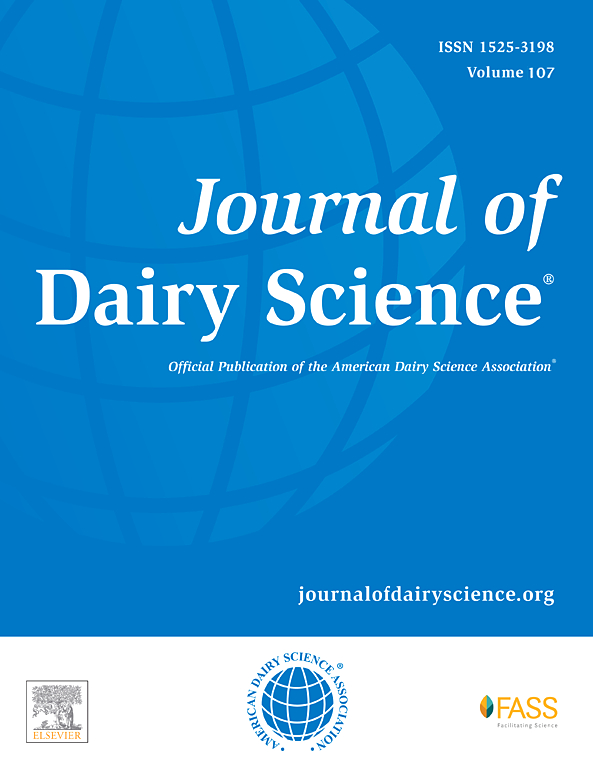在以青草和玉米为基础的奶牛饲养系统中,管理夏季饲料短缺的适应策略可提高动物的生产性能,并更好地保持牛奶和奶酪的质量。
IF 3.7
1区 农林科学
Q1 AGRICULTURE, DAIRY & ANIMAL SCIENCE
引用次数: 0
摘要
在以草为基础的半山地乳制品系统中,夏季干旱经常减少草的可用性,从而影响动物生产性能以及牛奶和奶酪的质量。本研究的目的是研究传统半山地草基系统与玉米基系统与兼职放牧的模拟夏季牧草短缺的影响。在19周的试验中,将26头荷斯坦奶牛和14头蒙巴姆扎德奶牛分成4组,每组10头。前8周,2组饲喂草基饲粮(75%的牧草,25%的干草和精料),其余组饲喂玉米基饲粮(75%的混合日粮,25%的牧草)。在接下来的11周内,每个饲喂系统中均有一组奶牛减少采食量,并相应增加室内采食量,草饲奶牛采食量为50%,玉米饲奶牛采食量为50%。除室内个体采食量外,还记录了整个试验期间的产奶量和乳成分。建立采食量模型以计算饲料效率和估算甲烷排放量。在实验结束时,从各组中抽取散装牛奶进行理化和微生物学分析,并加工成cantal型奶酪。成熟9周后,对奶酪进行理化、微生物学和描述性感官分析。结果表明:在玉米基体系中,完全去除牧草对产奶量没有影响,但降低了饲料效率;草基饲粮减草能较好地维持产奶量,提高饲料效率,降低甲烷排放强度。奶酪柔软度随草在饲粮中所占比例的增加而增加,与初级蛋白水解(α s1 -酪蛋白和β-酪蛋白分解)呈正相关,与C16:0/C18:1比值和计算脂肪熔点负相关。吃了更多草的奶牛的奶酪颜色最黄,味道最明显,而且异发酵乳酸杆菌和乳酸菌的数量也更高。从以玉米为基础的饮食中去除放牧的草,导致奶酪的黄色和味道更少,与次级蛋白质水解水平较低一致。总之,我们的研究表明,在以玉米为基础的饲粮中保持新鲜的牧草对保持奶酪质量而不影响动物生产性能至关重要。在以草为基础的系统中,与室内饲养相辅相成可能对产品质量影响有限,但可促进动物生产性能的维持。本文章由计算机程序翻译,如有差异,请以英文原文为准。
Adaptation strategies to manage summer forage shortages improve animal performance and better maintain milk and cheese quality in grass- versus corn-based dairy systems
In semi-mountainous grass-based dairy systems, summer droughts frequently reduce grass availability, with implications for animal performance as well as milk and cheese quality. The objective of our study was to investigate the effect of a simulated summer forage shortage in a traditional semi-mountainous grass-based system versus a corn-based system with part-time grazing. During a 19-wk experiment, 26 Prim'Holstein and 14 Montbéliarde cows were blocked in 4 balanced groups of 10 cows. During the first 8 wk, 2 groups were fed a grass-based diet (75% of grazed grass, 25% of hay and concentrates) and the remainder were fed a corn-based diet (75% mixed ration, 25% of grazed grass). During the following 11 wk, one group in each feeding system was subjected to a reduction in grazed grass intake and a corresponding increase in indoor feeding, resulting in 50% of grazed grass for grass-fed cows and removal of grazed grass for corn-fed cows. Milk yield and composition were recorded during the whole trial, in addition to indoor individual intake. Grass intake was modeled to calculate feed efficiency and estimate methane emissions. At the end of the experiment, bulk milk from each group was sampled for physicochemical and microbiological analyses and processed into Cantal-type cheeses. After 9 wk of ripening, cheeses underwent physicochemical, microbiological and descriptive sensory analyses. Results showed that the complete removal of grazed grass in corn-based system had no effect on milk production but impaired feed efficiency; grass reduction in the grass-based diet better maintained milk yield, enhanced feed efficiency, and reduced methane emission intensity. Cheese softness increased with proportion of grass in the diet, and it was positively correlated with primary proteolysis (αS1-casein and β-casein breakdown) but negatively correlated with the C16:0/C18:1 ratio and the calculated fat melting point. Cheese from cows fed with more grazed grass were the yellowest and had the most pronounced flavors, as well as higher counts of heterofermentative lactobacilli and lactic acid bacteria. Removal of grazed grass from the corn-based diet led to cheese that was less yellow and had less flavor, in line with lower levels of secondary proteolysis. In conclusion, our study suggests that maintaining fresh herbage in corn-based diets is crucial for maintaining cheese quality without impairing animal performance. In grass-based systems, complementation with indoor feeding may have limited effects on product quality but promotes the maintenance of animal performance.
求助全文
通过发布文献求助,成功后即可免费获取论文全文。
去求助
来源期刊

Journal of Dairy Science
农林科学-奶制品与动物科学
CiteScore
7.90
自引率
17.10%
发文量
784
审稿时长
4.2 months
期刊介绍:
The official journal of the American Dairy Science Association®, Journal of Dairy Science® (JDS) is the leading peer-reviewed general dairy research journal in the world. JDS readers represent education, industry, and government agencies in more than 70 countries with interests in biochemistry, breeding, economics, engineering, environment, food science, genetics, microbiology, nutrition, pathology, physiology, processing, public health, quality assurance, and sanitation.
 求助内容:
求助内容: 应助结果提醒方式:
应助结果提醒方式:


